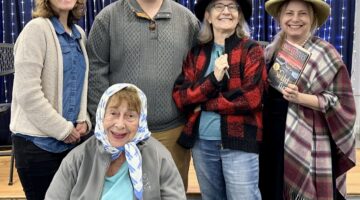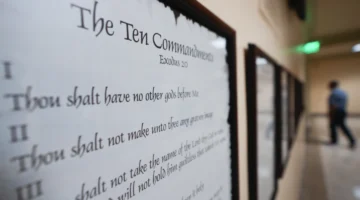Nobel Prize winner Michael Young delivers keynote at inaugural UF Circadian Symposium
GAINESVILLE, Fla. — A journey that led to a Nobel Prize may have begun with a neighbor’s elegant, blooming plant back in the hazy reaches of Michael Young’s Miami childhood.
The blooms opened at night, then closed in the day. Young didn’t know it then, but the plant was acting on instructions from its biological clock.
“That struck me at the time as quite surprising,” Young said. “And I didn’t understand much about it. But it produced an image that stuck with me.”
That curious boy would go on to help unlock an enduring mystery of biology: the mechanism underlying the circadian rhythms that tune multicellular life, including humans, to the rotation of our planet.
Young, Ph.D., the Richard and Jeanne Fisher professor and vice president for academic affairs at Rockefeller University in New York City, was the keynote speaker Friday at the inaugural University of Florida Circadian Symposium. Young shared the 2017 Nobel Prize in physiology or medicine with Jeffrey Hall and Michael Rosbash of Brandeis University in Waltham, Massachusetts, for what the Nobel committee called “paradigm-shifting discoveries.”
Karyn Esser, Ph.D, associate program director of the UF Institute of Myology and an organizer of the symposium, said UF was honored to have Young and other noted circadian researchers at the kickoff event. She said Young’s research was critical in advancing the field.
“Now we realize that these (biological) clocks are in our heart cells, our liver cells, every single cell in our body, and that disruption of these will have an impact on that cell type’s particular function,” said Esser, whose lab also has conducted pioneering research on the role of circadian rhythms and the molecular clock mechanism in the skeletal muscle organ system and health. “I would predict that you are going to see a tremendous escalation in work on circadian rhythms related to medical therapeutics and strategies.”
During his symposium presentation, “Genes controlling sleep and circadian rhythms,” Young talked about his lab’s work researching delayed sleep cycle disorder, which affects about 5 percent of the U.S. population. Sufferers might be thought of as night owls who can’t find sleep until the early hours of the morning.
“There’s a significant delay in the timing of sleep,” Young said. “Patients that you see assure you that they’ve tried everything they can think of to maintain a schedule that will allow them to be in step with the rest of the world.”
While some causes may be environmental, Young said, his lab was able to identify a gene mutation that produces a night owl effect that is present in about 1 percent of the world’s population, although the incidence is much higher among those of European descent.
Our biological clocks adapt our bodies to the 24-hour cycle of the Earth, anticipating the rise and fall of the sun that ultimately gives all life a survival edge. So, that night-blooming plant from Young’s childhood was anticipating pollinators that are only active in the evening.
In humans, circadian rhythms are expressed in numerous ways. Our highest testosterone secretion comes at 9 a.m., our highest alertness an hour later. By early afternoon, our best coordination and fastest reaction times are recorded. Around 5 p.m., our bodies are working at their greatest cardiovascular efficiency and muscle strength. We tire in the evenings and awake in the mornings based on that internal timekeeper.
Using fruit flies, Young and the other Nobel-winning scientists isolated the gene that controls the circadian rhythm. (The word circadian is derived from the Latin “circa,” or “around,” and “diem,” or “day.”) The gene, Period, encodes a protein called PER that accumulates in the cell during the night before degrading by day.
Young was able to prove why PER went up and then down like the hands on a watch dial after he discovered the Timeless gene. Timeless produced a second protein, TIM, that binds itself to the PER protein. Together, they then enter the cell nucleus and block period gene activity, closing the loop until the cycle begins anew.
They “were physical partners,” Young said of the proteins. “To me, this was an epiphany.”
These discoveries opened an often surprising path to better understand circadian rhythms in all of biology. Now, scientists could consider the role of circadian rhythms in a wide variety of diseases.
For example, researchers have found evidence that workers on night shifts disrupt their internal clock, perhaps raising the risk of cancer. Jet lag, the signature of a cranky circadian rhythm, might actually disrupt the cycle of hundreds of genes needed to maintain good health, scientists have found.
“A lot of surprises have come from just learning in molecular detail how many things are regulated in this way in so many tissues, in so many organ systems,” Young said before the event. “We started with sleep and wakefulness. But it’s the same clock doing this in every organ of our body.”
This system of chemical oscillations, like the instruments of an orchestra working together to create beautiful harmonies, is now understood as being critical to all life because of Young and his fellow Nobel luminaries.
At the conclusion of his talk before a packed auditorium with several hundred UF students, faculty and staff, Young said, “And finally, the real hero.”
On a large screen, he projected the image of a fruit fly.
Young joined a list of notable circadian researchers at the symposium who included Jay Dunlap, Ph.D., of the Geisel School of Medicine at Dartmouth College in Hanover, New Hampshire; Carrie Partch, Ph.D., of the University of California at Santa Cruz; Nicholas Foulkes, Ph.D., of the Karlsruhe Institute of Technology in Karlsruhe, Germany; Tami Martino, Ph.D., of the University of Guelph in Ontario, Canada; and John Hogenesch, Ph.D., of the Cincinnati Children’s Hospital.
The Circadian Symposium was sponsored by the UF Joseph and Leila Applebaum Visiting Professorship; the Evelyn F. and William L. McKnight Brain Institute of the University of Florida; and the UF College of Medicine’s department of physiology and functional genomics.
[livemarket market_name="KONK Life LiveMarket" limit=3 category=“” show_signup=0 show_more=0]


No Comment